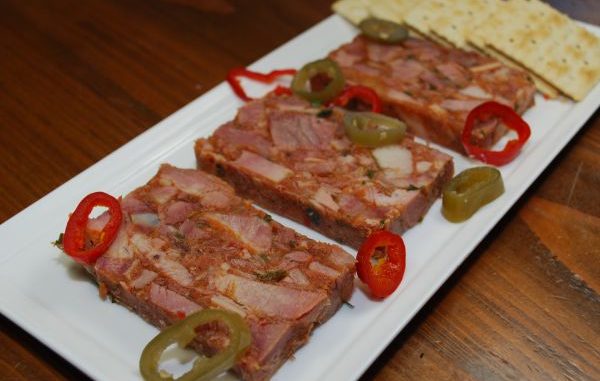
Hog’s head cheese, of course, isn’t a cheese made of dairy products; rather, it is a meat jelly known to professional cooks as a “terrine.”
It originated as a peasant food in Europe in the Middle Ages, and only “scrap” parts including the head (minus the eyes, brains and ears), tongue, feet and even skin of the animal were used.
As it became more popular — literally fit for kings — more meat from “noble” cuts such as hams and loins were added.
Mark Falgoust’s version does not include the feet because they are a lot of work to clean, so to provide enough gelatin to bind the product together, he adds commercial gelatin sheets.
He scrapes the head free of hair using a bell scraper, which can be purchased online at Amish Web sites.
Use your seafood boiling rig, with its large pot, to make this dish.
You can’t rush hog’s head cheese. Making it is an all-day affair, although with proper beverages it’s a lot of fun.
Slowly reducing the liquid with heat and skimming it constantly are the keys. Skimming the impurities off the liquid’s surface every few minutes is important; if not done, the impurities will muddle the wonderful pork flavor of the final product. Good hog’s head cheese will have a non-greasy mouth feel, with sharp, crisp flavors.
The product should be slightly over-seasoned before it is put in the molds for refrigeration because foods to be eaten cold need more seasoning than hot foods.
Falgoust stressed that it is important to get 2 parts meat to 1 part liquid before molding to get a sliceable product. The ratio is important.
To see if the hog’s head cheese will set up properly, spread a couple of tablespoons of it in a small bowl and put it in a refrigerator. If it is rubbery or mushy, add water or gelatin as necessary to the mixture before ladling it into the molds.

Hog’s head cheese, Falgoust said, can be made without the head — but the tongue, ears, snout and cheek meat give the final product its unique texture. It is wonderful.
Here’s his recipe:
Mark’s Hog’s Head Cheese
50 lb. pig parts with the bones, head and heart
Chicken stock
1 gal. diced red bell pepper
2 gal. diced green bell pepper
2 gal diced celery
2 gal. diced onions
2 cups diced garlic
20 bay leaves
1/4 cup parsley
3/4 cup green onions
1/4 cup hot sauce
15 gelatin sheets
Pour enough water in a pot large to cover the pig’s head, and heat to 170 degrees. Cut holes in the pig’s ears to use as handles when dipping the head in the hot water.
Periodically test by pulling on the hair. When the hair begins to loosen, remove the head from the pot. Use a bell scraper to remove the hair from the pig’s head.
Saw the scraped head in half lengthwise, and remove and discard the eyes and brain.
Clean the heart by splitting in vertically and trimming away the arteries and connective tissue at the top of each half.
Place the cleaned head, the cleaned heart and other pig parts in a separate pot. Add half chicken stock and half water to cover the meat by 3 to 4 inches. Add bell pepper, celery, onions, garlic and bay leaves.
Bring to a boil, and then turn down to a simmer and cook until tender, about one hour. Skim often to remove any grease and scum.
Remove the meat from the pot and spread it out to cool for easier handling. Remove the bones and about three-quarters of the fat.
Return the liquid to the heat and reduce by 75 percent. Continue to skim.
Using your fingers, remove the meat from the head and the bones. Cut the meat into bite-size pieces. Thinly slice the ears and snout, and mix with the meat in a bowl.
Discard everything that is not obviously meat.
Add parsley, green onions and hot sauce.
In a separate bowl, soak the gelatin sheets in ice water to soften. Squeeze the water out of the softened sheets, and add two to three cups of the reduced liquid in a pan with the gelatin to dissolve it.
Stir this into the meat mixture, and then add enough liquid to the mixture to form the consistency of a thick stew. Taste for seasoning.
Ladle the mixture into molds and refrigerate until firm.


